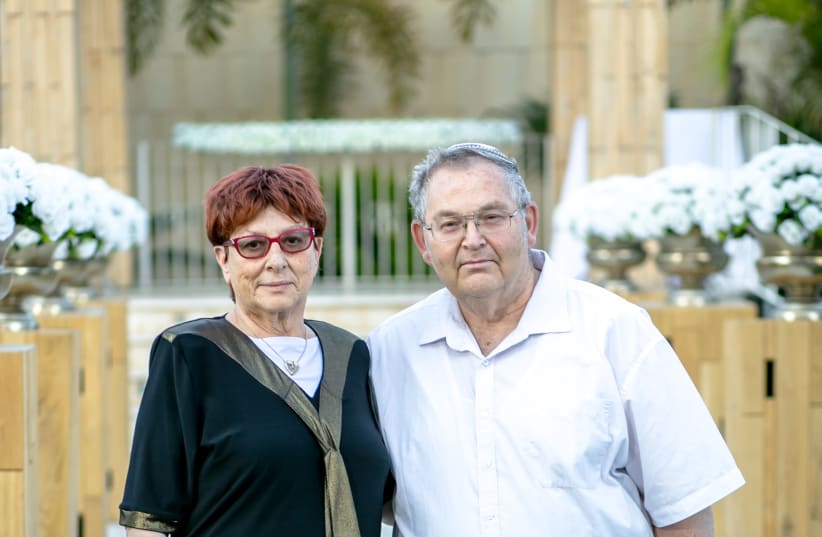When Moshe and Hadassah Goldberg made aliyah in 1963, Moshe’s parents begged them to return to Brooklyn. But the newlyweds stayed and became an integral part of the Neve Sha’anan neighborhood of Haifa.
In the years following the Six Day War, Moshe’s parents decided to join them in Neve Sha’anan – as did Moshe’s brother Shlomo and his wife Esther, Hadassa’s mother, and Hadassa’s sister Sarah and her husband Rafi Goodman. The next generation grew up together there.
Moshe says the clan was so well-known in Neve Sha’anan that when their neighbor, an Egged driver, heard English-speaking strangers on his bus he would ask them, “Which of the Goldbergs are you looking for?”
Moshe and Hadassah met in 1958 at a Bnei Akiva Shabbaton and later worked together at the Zionist youth movement’s Camp Moshava. In 1960, Moshe started his master’s degree in chemical engineering at the Massachusetts Institute of Technology. Half a year later, he came to Beersheba for a semester through the Jewish Agency program, Professional and Technical Workers Aliyah.
“When I arrived back in the US, we got engaged. When I finished MIT in 1962, we got married. At that time, within two weeks, eight couples from Bnei Akiva got married,” Moshe relates. “We were greatly influenced by Rabbi Haim Druckman, who was the shaliach [emissary] in New York for Bnei Akiva. Some of our children and grandchildren are connected to his yeshiva, Or Etzion, to this day.”
Moshe was born in 1939 in Wheeling, West Virginia. His father was a rabbi and kosher butcher. The family relocated to New York when Moshe was six; his father would later become a New York State kosher inspector.
Moshe remembers singing and dancing when he heard that the UN had voted for the partition plan of Palestine. He joined Bnei Akiva at age nine and remained an active member throughout elementary and high school at the Brooklyn Talmudic Academy.
Hadassah comes from a less conventional background. Her parents, originally from Poland, had moved to Dortmund, Germany, and owned a store that was ransacked on Kristallnacht, November 9, 1938. Her father was arrested. Six weeks later, her mother managed to get him released with a forged visa. The couple and their two daughters embarked on a long, precarious escape that took them to Belgium, where her father learned the diamond trade, and eventually to Cuba in 1941. Hadassah was born 10 days after their arrival.
“We came during Batista’s reign. Foreigners were not allowed to work. The Jews convinced Batista to begin a diamond industry that would employ 50 percent Cubans and 50 percent Jews,” Hadassah explains.
But before Hadassah began first grade, her uncle in the US vouched for the family and they moved once again, to the Washington Heights neighborhood of Manhattan where there were many Jewish European refugees. Hadassah and her sister Sarah wrote the book Fleeing Europe about their experiences.
There was never a question for either Moshe or Hadassah that Israel would be the place to raise their family. “We firmly believe this is our home. We always felt this is the place we have to be,” says Moshe.
He earned a doctorate in chemical engineering and worked at the Technion-Israel Institute of Technology and later in the private sector. For 10 years before his retirement, he went back to the Technion to work in the computer center.
Hadassah was employed in the Technion’s library for two decades and helped found the Haifa branch of Emunah Women. She also tutored some 30 young women over the years to prepare them for their conversion.
THE GOLDBERGS we were very involved in their synagogue and in the Merkaz Dati L’Noar community center for religious teenagers. For about 20 years, Moshe regularly translated the weekly shul bulletin into English, which was distributed via email and in printed form in North American synagogues.
He also translated Druckman’s book Kim’a Kim’a into English, as Step by Step. The book, which quotes sources leading to the conclusion that Israel is the fulfillment of the prophecies of redemption, was published by Or Etzion a year ago.
The Goldbergs raised four children, who currently live in Hoshaya, Netufa, Kiryat Malachi and Psagot, respectively. They now enjoy a growing number of great-grandchildren.
In 2018, the Goldbergs made the difficult decision to leave Haifa and move to a senior residence in northern Jerusalem. The “transplant” was quite successful.
“We are very happy here,” Moshe says. “It gives us a framework. There are several shi’urim, Hadassah exercises every day, we have events and trips, music shows and lectures.”
Moshe has given some of the lectures. One was about a letter he found among his father’s papers, dated 1920.
“The letter was from my father’s uncle asking his brother, my grandfather, not to stay in the US but to come back to Russia ‘because there’s no Yiddishkeit in the US.’ Of course those who stayed in Russia got caught in the Holocaust,” he says. “Many years later, when my parents sent us a message to come home and not stay here in Israel, it was reminiscent of that letter from my father’s uncle.”
But life was not easy in the 1960s. “It really was hard to live here in those days,” Moshe admits. “When my parents came to visit, they went home feeling bad about how primitively we were living, although we did not feel that. We had great support from Israelis living in Neve Sha’anan and I’m not sure what we would have done without that support.”
Moshe feels that their aliyah also was successful because they came together with like-minded immigrants.
“It has been a great privilege to be part of a group that made aliyah from the US in the ’60s and ’70s,” he says. “Many of our friends are prominent in various fields and we have all worked to help Israel achieve its goals.” ■
THE GOLDBERGS: MOSHE, 82, AND HADASSAH, 80From Brooklyn to Haifa, 1963

